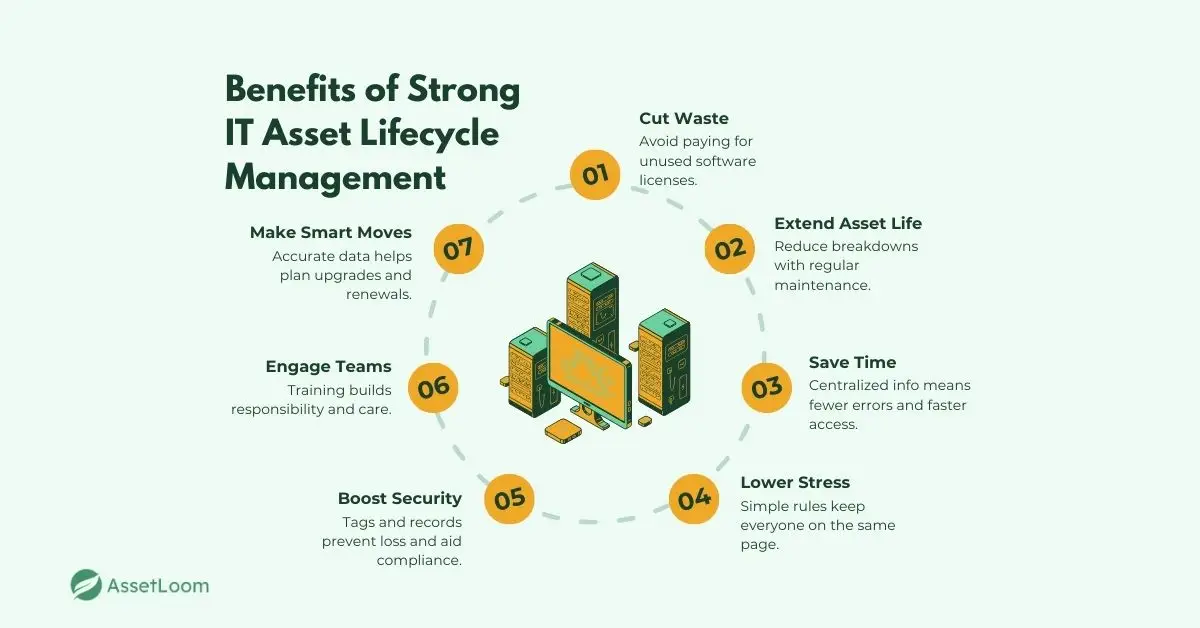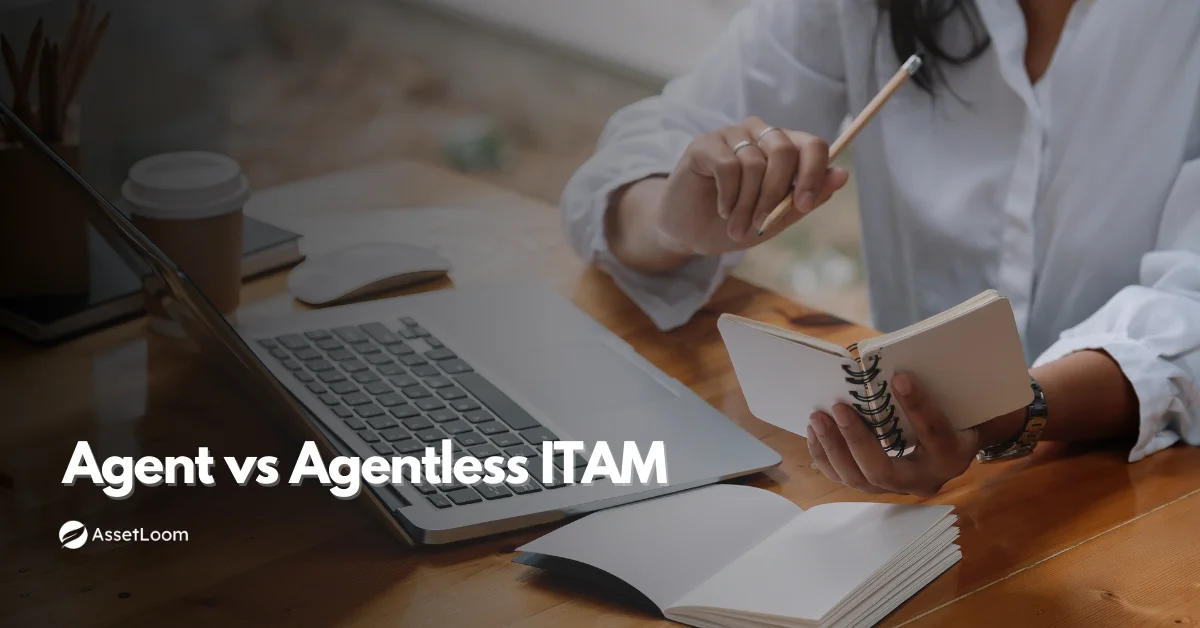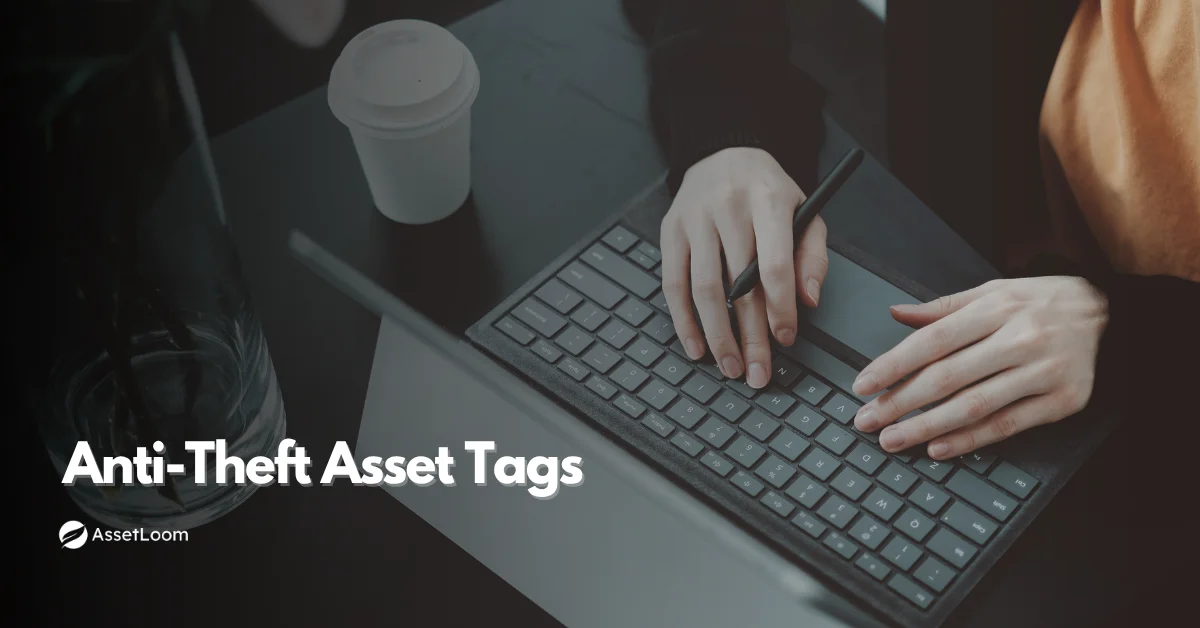7 Practical Tips to Improve Your IT Asset Lifecycle Management Processes
Get 7 quick tips to improve IT asset lifecycle management processes and boost efficiency across your IT operations.
If you’re already using IT asset management (ITAM) software, you’re ahead of the game when it comes to tracking your hardware and software. But even with the right tools, it’s common to hit roadblocks like outdated data, inconsistent processes, or missed opportunities for automation.
Maybe your asset records aren’t always accurate. Or your teams use different methods to handle assets, creating confusion. Perhaps compliance audits still feel stressful, or you want clearer insights to cut costs and boost efficiency.
Improving your IT asset lifecycle management process means making your current system work smarter, not harder.
In this post, we’ll share 7 practical tips designed to help you optimize your existing ITAM workflows. These tips will help you reduce risks, save money, and get more value from the software you already have.
7 Tips to Boost Your IT Asset Lifecycle Management
Now, let’s dive into 7 straightforward tips that can help you sharpen your IT asset lifecycle management processes and get the most out of your ITAM software.
1. Keep Asset Information Accurate Throughout the Lifecycle
Having all your IT asset details in a single, easy-to-access location is key to managing their lifecycle smoothly. This includes purchase dates, warranty info, current users, maintenance records, and more.
Using a centralized system reduces confusion and makes it easier to find the right information when you need it. For example, a healthcare provider who keeps all device details in one place can quickly schedule repairs without delays.
With organized data at your fingertips, it’s easier to stay ahead of maintenance, something that plays a big role in asset longevity.
2. Set Up Automatic Maintenance Reminders
Maintenance is an important part of keeping assets healthy throughout their lifecycle. Setting up automated reminders for tasks like software updates or hardware checkups means you won’t miss important deadlines.
A retail company that automates maintenance alerts prevents unexpected breakdowns during busy sales seasons. If a POS terminal or inventory scanner fails right before a holiday rush, it could delay checkouts, frustrate customers, and lead to lost sales.
Once maintenance is under control, the next natural step is to pay attention to how your assets are actually being used day-to-day.
3. Watch How Assets Are Used
Tracking how and when your assets are used helps you make smarter decisions. Are devices being used efficiently? Are some assets sitting idle or overworked?
A tech firm that monitors usage can identify underused equipment and reallocate resources to where they’re needed most. Without this insight, teams might waste time waiting for shared devices or continue overusing a few assets while others sit idle, leading to faster wear and unnecessary purchases.
When you understand asset usage better, protecting those assets from loss or theft becomes a top priority.
4. Use Tags or Trackers to Prevent Loss
Loss or theft can seriously disrupt your IT asset lifecycle management. Using tools like RFID tags, QR codes, or GPS trackers makes it easier to locate assets and prevent them from going missing.
An educational institution that tags laptops can quickly find any that go missing, reducing replacement costs and downtime. If devices aren't tracked, a lost laptop might go unnoticed until a student urgently needs it for exams or remote learning, putting them—and staff—in a tough spot.
Of course, physical protection works best alongside clear, simple rules that everyone can follow.
![]()
5. Create Simple Rules for Asset Handling
Clear and easy-to-follow rules help everyone understand their role in managing IT assets. This can include check-in/check-out procedures, who’s responsible for maintenance, and how to report issues.
A healthcare clinic with simple asset policies reduces confusion and ensures devices are properly cared for throughout their lifecycle. Without clear check-in/check-out rules, a vital diagnostic device might get misplaced or forgotten between departments, delaying patient care.
When processes are clear, staying on top of software licenses becomes easier and more reliable.
6. Stay on Top of Software Licenses
Software licenses are a critical part of IT assets, but can be tricky to manage. Keeping track of licenses helps avoid paying for unused subscriptions or facing compliance issues.
A retail chain that monitors license usage regularly can save money and avoid audit headaches. If expired licenses go unnoticed, the company could face unexpected downtime during an update or even fail a compliance check, both of which can hurt operations and reputation.
Keeping licenses in check supports the whole asset management process, and the best way to verify everything is accurate is through regular audits.
7. Train Your Team and Get Everyone Involved
Finally, training your team and involving all stakeholders ensures everyone knows their part in managing IT assets. Regular training sessions help build a culture of responsibility and continuous improvement.
A tech company that engages employees across departments sees fewer mistakes and better asset care. If staff aren’t trained, they may unknowingly mishandle equipment or skip key steps, leading to more breakages, longer support tickets, and a less efficient system overall.
When everyone understands their role, your IT asset lifecycle management runs smoothly and effectively over time.
Benefits and Metrics
Putting these tips into practice can bring real, positive changes to how your IT asset lifecycle is managed. Here’s what you can expect:
- Cut Down on Waste: Tracking software licenses carefully can reduce wasted spending by around 12%, according to the 2024 State of ITAM Report. This means fewer unused licenses and better budget use.
- Help Your Assets Last Longer: Regular maintenance and watching how assets are used help prevent breakdowns and extend the life of your equipment.
- Save Time and Effort: Keeping all asset info organized in one place means less time searching for details or fixing errors, so your team can focus on more important work.
- Reduce Stress with Clear Rules: Having simple, easy-to-follow guidelines for handling assets reduces confusion and mistakes across the board.
- Improve Security and Compliance: Using tracking tools and keeping good records helps prevent loss and ensures you meet legal or industry requirements.
- Boost Team Engagement: Training and involving your whole team creates a sense of responsibility, leading to better care and fewer oversights.
- Make Smarter Decisions: With accurate data and real-time insights, you can plan better, whether it’s replacing old equipment or renewing software licenses at the right time.

These benefits don’t just help save money—they also make your day-to-day IT asset management smoother, less stressful, and more effective overall.
Wrapping It Up
Improving your IT asset lifecycle management doesn’t have to be hard. These simple tips help you get more from the tools you already use. Keeping your asset info organized and up to date, setting reminders for maintenance, and tracking how assets are used will help you avoid surprises and save money.
Having clear rules and using tracking tools protects your assets and makes everyone’s job easier. Keeping an eye on software licenses helps you cut costs and stay audit-ready. And when you train your team and get everyone involved, managing your assets becomes a smooth, team effort.
Try a few tips today, and watch your IT asset lifecycle improve step by step.

Subscribe for Expert Tips and Updates
Receive the latest news from AssetLoom. right in your inbox

